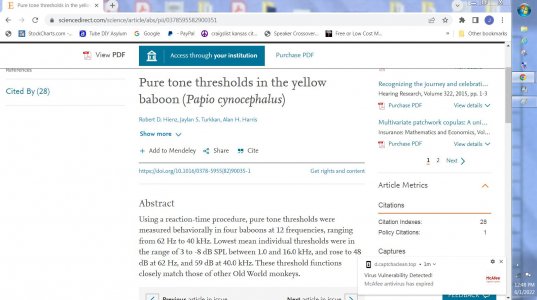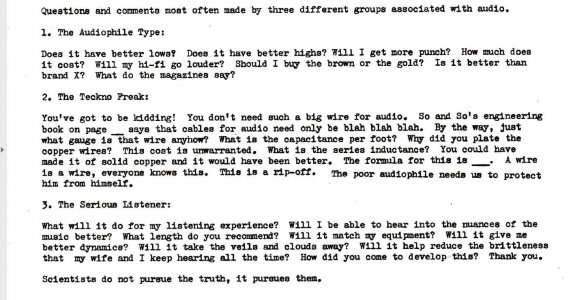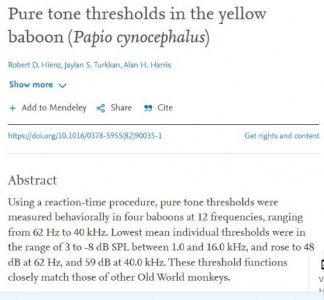Ok. Then one needs to ponder on this. This means reflections are possible for digital cables, definitely not for analog and speaker cables.Yes, it is in MHz region. See the pdf paper in the second search result. The clock speed differs for different sampling rates.
2 times x X kHz signal sampling rate x 64 = Y MHz, is the clock speed. For 192 kHz the clock speed is about 24 MHz.
You are using an out of date browser. It may not display this or other websites correctly.
You should upgrade or use an alternative browser.
You should upgrade or use an alternative browser.
Fulton Length Wires
- Thread starter Hari Iyer
- Start date
Yes, transmission line theory applies. Reflections, standing waves, impedance matching, etc apply. FWIW, after learning about the idea of 1.5m long (or whole number multiples) digital coax cables, I have always made my digital coax cables 1.5m. Don't ask me if I heard a difference.Ok. Then one needs to ponder on this. This means reflections are possible
Subbu68
Well-Known Member
Yes, it is in MHz region. See the pdf paper in the second search result. The clock speed differs for different sampling rates.
2 times x X kHz signal sampling rate x 64 = Y MHz, is the clock speed. For 192 kHz the clock speed is about 24 MHz.
Other than the basic electronics in 2nd and 3rd year all my studies and career has been in power systems. So digital signals and processing are a bit alien to me.Ok. Then one needs to ponder on this. This means reflections are possible for digital cables, definitely not for analog and speaker cables.
But when we specify OFC for power system comms it is specified at 1300nm. For SPDIF I read it as 650nm. Is it not this wavelength / frequency at which the signal is transmitted that matters? I have heard my telecom colleagues speaking about attenuation due to joints and terminations but not reflections. OFCs work on the principle of total internal reflection? That is for lines like 200 to 300km.
In a 1.5m or 3m SPDIF OFC with just two connectors at the two ends, would there be such reflections to combat?
Let's assume you don't mean to insult others, but then you go on to say
Baboons don't hear beyond 700 Hz. Yes they can make vocals little beyond what humans can make
MECHANICAL PROPERTIES OF BABOON TYMPANIC MEMBRANE FROM YOUNG TO ADULT
The tympanic membrane (TM) or eardrum of the ear transfers sound waves into mechanical vibrations in the ossicular chain and into the cochlea. The mechanical properties of the TM play an important role in the sound transmission through the ear. Currently, the mechanical properties for the adult...shareok.org
So not sure the research your mentor did on baboons, how he figured out the frequency range that baboons could hear, how he figured out what baboons heard, was he in direct touch with them. Some links to his research would help.
So when people have heard cables contrary to fulton lengths, one may assume that what is said about Fulton lenghts may not be true.
There is nothing in this world that happens without an explanation. For some we don't have answers. For many we do have answers. For any phenomena where we don't have answers, the best is to leave it to science and people more knowledgeable than us, regardless of our own personal experience. For thousands of years people believed that earth is flat and is the center of the universe because that's what they experienced. Now we know that's not true.
Sir,
Kindly tell us all, how (and why) did you post about baboons maxing @ 700 Hz. ?? I found this entry within 2 minutes.

Sir,
Kindly tell us all, how (and why) did you post about baboons maxing @ 700 Hz. ?? I found this entry within 2 minutes.
View attachment 69671
This was the test conditions. What were the results? It would help immensely if the links to the original study done by the mentor were mentioned. Else it just becomes hearsay. So how did your mentor conclude that Baboons found fulton lenghts to be the best length?
Once you start backing your claims with original research, people will appreciate it.
This is what puzzles me. So more reading to do.In a 1.5m or 3m SPDIF OFC with just two connectors at the two ends, would there be such reflections to combat?
Your assumptions and understanding, may or may not be correct. Mr. Fulton tested this in his Lab, in a scientific way. It was all analogue !!Ok. Then one needs to ponder on this. This means reflections are possible for digital cables, definitely not for analog and speaker cables.
In the 1980s, he was using 2 GIG Tek scopes to study audio, and often told me he was continually amazed at what he saw.
Jeff
My post's URL is readable, download the URL's PDFs and educate yourself. Study it on and off line for yourself. There must be plenty of others on line also. Do not cast doubts on my posts. You never ever did answer the question, HOW and WHY ???This was the test conditions. What were the results? It would help immensely if the links to the original study done by the mentor were mentioned. Else it just becomes hearsay. So how did your mentor conclude that Baboons found fulton lenghts to be the best length?
Once you start backing your claims with original research, people will appreciate it.
Jeff
Which creates an impasse. With no access to actual data that can be proven by others, it means either Fulton is right or others who find no difference with other lengths are right. The world will always go with those who can prove it consistently and with repudiation under all conditions.Your assumptions and understanding, may or may not be correct. Mr. Fulton tested this in his Lab, in a scientific way. It was all analogue !!
In the 1980s, he was using 2 GIG Tek scopes to study audio, and often told me he was continually amazed at what he saw.
I was referring to electrical digital coaxial transmission medium.Other than the basic electronics in 2nd and 3rd year all my studies and career has been in power systems. So digital signals and processing are a bit alien to me.
But when we specify OFC for power system comms it is specified at 1300nm. For SPDIF I read it as 650nm. Is it not this wavelength / frequency at which the signal is transmitted that matters? I have heard my telecom colleagues speaking about attenuation due to joints and terminations but not reflections. OFCs work on the principle of total internal reflection? That is for lines like 200 to 300km.
In a 1.5m or 3m SPDIF OFC with just two connectors at the two ends, would there be such reflections to combat?
"nm" specifies the wavelength of the light used in fiber optics. This wavelength defines the carrier wave. This carrier wave must be modulated (switched on and off so many times per second to transmit the bits) with the info it needs to carry and the bitrate decides the clock speed.
This is signal in < 20 kHz domain. Few cm here and there wouldn't make any difference. Only a cable manufacturer will want you to believe otherwise.My post's URL is readable, download the URL's PDFs and educate yourself. Study it on and off line for yourself. There must be plenty of others on line also. Do not cast doubts on my posts. You never ever did answer the question, HOW and WHY ???
Subbu68
Well-Known Member
Where is Society for the Prevention of Cruelty to Animals (SPCA) ? People are testing audio on animals!!!
Why not use their pet dogs that can hear in ultrasonic range or their little ones with sensitive hearing?!!!!
Why not use their pet dogs that can hear in ultrasonic range or their little ones with sensitive hearing?!!!!
All it says isMy post's URL is readable, download the URL's PDFs and educate yourself. Study it on and off line for yourself. There must be plenty of others on line also. Do not cast doubts on my posts. You never ever did answer the question, HOW and WHY ???
Jeff
Mechanical properties of the Papio anubis tympanic membrane: Change significantly from infancy to adulthood. The paper has to be purchased. It makes no claims to the superior hearing of the baboons. Even if baboons have vastly superior hearing, let us know how this was used in research to conclude the with the help of baboons, it was determined that the Fulton length is the best length.
I'm sure the our amplifiers are not meant to be heard by baboons
This was the test conditions. What were the results? It would help immensely if the links to the original study done by the mentor were mentioned. Else it just becomes hearsay. So how did your mentor conclude that Baboons found fulton lenghts to be the best length?
Once you start backing your claims with original research, people will appreciate it.
The baboons never got sick after the wire change, and the University Lab never had to call Mr. Fulton back.
This is signal in < 20 kHz domain. Few cm here and there wouldn't make any difference. Only a cable manufacturer will want you to believe otherwise.
So you think.
But you never did the lab work, as Fulton did. He was also an excellent musician.
Music and audio is not narrow band. His 7-way speaker designs in the 1980s speced + or - 2 dB, from 12 Hz to 80 kHZ.
Resultants, high above our range of hearing, continuously travel down to where we can easily perceive them.
As Robert Fulton wrote in his paper on wire, something to the effect of : " What is obvious in science is not always so ".
Jeff
So you comment without knowing about me. I have indeed spent a good time in labs trying to achieve success after multiple failuresSo you think. But you never did the lab work, as Fulton did.
So you comment without knowing about me. I have indeed spent a good time in labs trying to achieve success after multiple failureswhich kept on delaying my thesis before I could defend it successfully in 1991. That's the thing about science. The world doesn't care about how much effort you spend on it. The only thing that matters is the truth and not vodooo or claims about supernatural experience
It is evident to all of us that you were involved in science. It all sounded cool to me !!! Bravo. for you and to you.
But your Lab work was not music and audio-centered was it ? There is no vodoo as you worded it here, just certain narrowly educated peoples' inabilities to accept something with a different approach. It is their problem and often times a loss, certainly not mine. And there is nothing supernatural here as you worded it.. For me in audio since 1978, it became all about finding the best two audio Mentors and learning from them, while LISTENING to my own DIY builds, 1982 on.
Peace be with you,
Jeff
Here, from 1978 is how Robert ended his paper on wire.....seemingly applicable today. Where personally, of the three, do each of you reading this, best fit in ??

Last edited:
Subbu68
Well-Known Member
Maybe baboons did not hear anything above 20kHz??? OR Did they dance to US music?


Just my doubts
Just my doubts
Maybe baboons did not hear anything above 20kHz??? OR Did they dance to US music?
Just my doubts.
Reread this as a start :

Please consider this :
" Our doubts are traitors. And make us lose the good we oft might win. By fearing to attempt . "
.................................................................................................William Shakespeare.
................................................................ Plus 59 dB, at 40.0 kHz.
Jeff
Last edited:
Where is Society for the Prevention of Cruelty to Animals (SPCA) ? People are testing audio on animals!!!
Why not use their pet dogs that can hear in ultrasonic range or their little ones with sensitive hearing?!!!!
Wow. What a non-thought-out first sentence. !!
There are companies in the USA, whose sole business is to supply properly obtained animals, for Laboratory study, to bonified end-users. I know this for a fact, because my Mother worked for one in the late 1950s. Certainly, a Laboratory at the University of Minnesota in the 1970s, a major University, would comply with the rules that pertain to test animals.
Re: your second paragraph : It seems to me that you have not taken the time to read and acquaint yourself with Mr. Robert W. Fulton's biography. You should educate yourself fully about audio people you make fun of.
Written by his son, Richard Fulton :

Jeff
Last edited:
Subbu68
Well-Known Member
No time for these.Wow. What a non-thought-out first sentence. !!
There are companies in the USA, whose sole business is to supply properly obtained animals, for Laboratory study, to bonified end-users. I know this for a fact, because my Mother worked for one in the late 1950s. Certainly, a Laboratory at the University of Minnesota in the 1970s, a major University, would comply with the rules that pertain to test animals.
Re: your second paragraph : It seems to me that you have not taken the time to read and acquaint yourself with Mr. Robert W. Fulton's biography.
Written by his son, Richard Fulton :
View attachment 69707
Jeff
Worried more about power system harmonics, PARTIAL DISCHARGES, protection faults, electrocution deaths etc.etc.
Purchase the NEW Audiolab 6000A MkII Integrated Amplifier at a special offer price.
Similar threads
- Replies
- 7
- Views
- 25K
- Replies
- 29
- Views
- 23K

